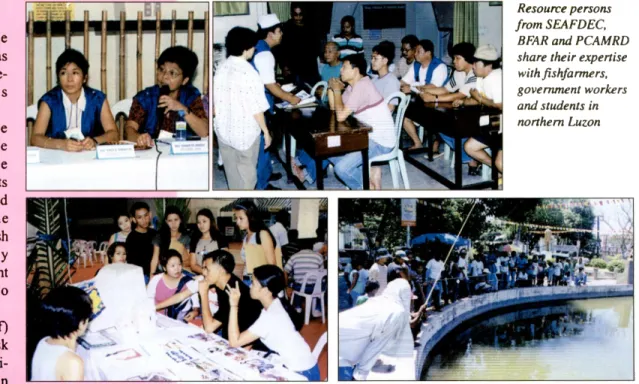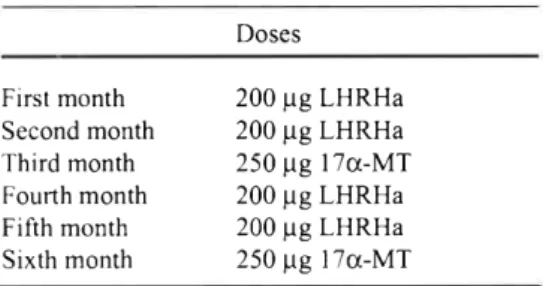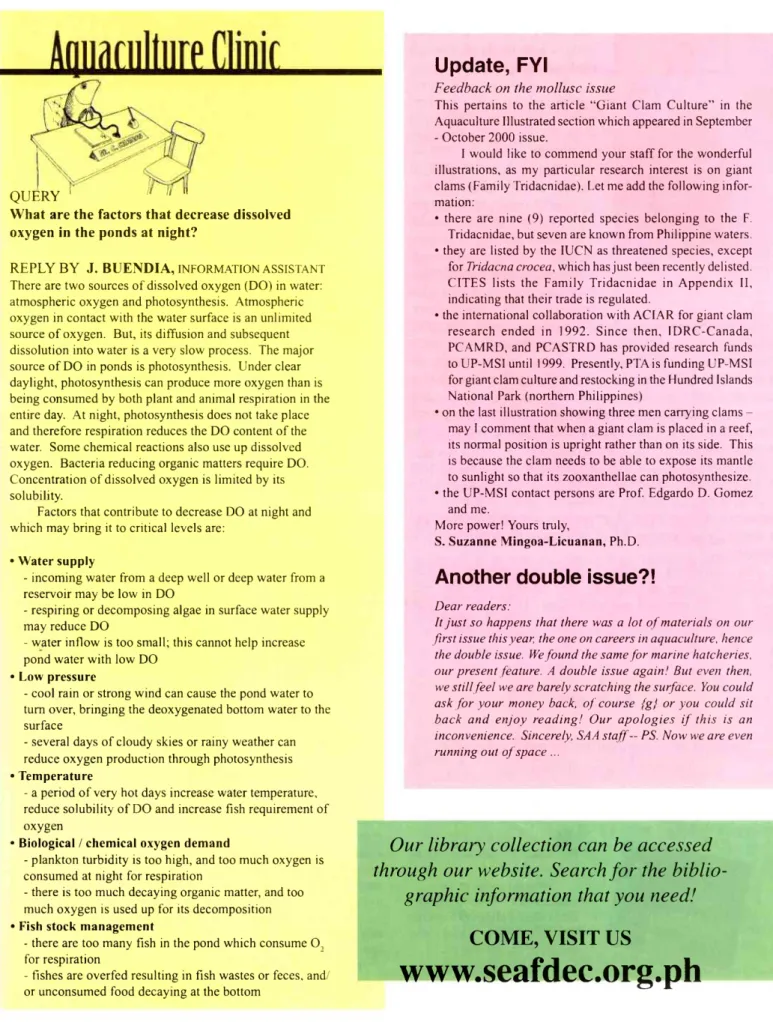Recognition of SEAFDEC/AQD as one of the most relevant research institutions in the Philippines and in Southeast Asia, Agricul. At the site, AQD conducted baseline environmental assessment in collaboration with the Philippine government.

AQD hosts ACIAR seminar on grouper
AQD in JICA exhibition
AQD celebrates Aquaculture Week 2001
Workshop pushes creation of Code of Practice for seaweed industry
In the present study, we used GABA to increase rotifer reproduction and rotifer swimming activity in enrichment cultures. Although food consumption differed significantly between treatments, there were no significant differences in body mass development.
SEAFDEC/AQD Seminar Series
Since then, she has contributed significantly to the development of human resources in the region in the field of tropical biology. Susana Siar: knowledge of gender, space and resources in small-scale fisheries - the case of Honda Bay, Palawan.
Health management in aquaculture
Emata's study showed that sexual maturation among male red snappers occurs in the fourth year of rearing, among females in the fifth year. Under bright daylight, photosynthesis can produce more oxygen than is consumed throughout the day by plant and animal respiration.
Update, FYI
No photosynthesis takes place at night and therefore respiration reduces the DO content of the water.
Another double issue?!
COME, VISIT US
TAIWAN, INDONESIA, PHILIPPINES
There is great potential for the live fish market, but production is limited due to low hatchery survival rates. Like the group, the red one is also in high demand both in the domestic and foreign markets. In the late 1970s, milkfish and grainfish were added to the growing list of marine fish bred.
The author has conducted some studies on the preparation of milkfish broodstock for hatchery use. These criteria should be used to ensure quality production of milkfish fingerlings in the hatchery. Successful milkfish broodstock spawning occurs in the rearing tank using LHRHa (luteinizing hormone-releasing hormone analog) and MT (17α methyl testosterone) implanted into the broodstock to accelerate gonadal maturation.
Harvesting of fry is carried out after 2 1 - 2 5 days by lowering the water level in the tank and transferring the fry to the bowl.

W here are the captive milkfish breeders?
Producing and selling milkfish fry
NCAMFRD researchers are awaiting the arrival of the Iloilo breadstick that came from the University of the Phil. The natural food circular tank (1) and larva rearing tank (2) at the Aznar milkfish hatchery in Talisay, Cebu. The cages (2 sizes, seven 10 and two 6 m dia, 3 m depth) are framed with polyethylene pipe and fiberglass at the top and bottom to maintain its shape while in use.
His birds are fed commercial pellets while his larvae are fed Chlorella and rotifers, not unlike other commercial crops. His consultant, Albert Gaitan, says they currently have a million fries, but no buyers. He further says that the Philippines should be exporting fried by now, and not al.
In addition, they say more cultivation processing plants need to be set up.
Update on BFAR’s saline tilapia breeding
Given its number of breeders with the above survival rate, its average production may be modestly large, indicating a surplus for the hatchery market. It is the import of fry from Indonesia and Taiwan that saturates the market in Luzon.” They say imported fry from Taiwan and Indonesia, which are flooding the Luzon market, should be regulated, especially during peak months when the availability of wild fry is high.
Sex-reversal in an all-male tilapia is done to ensure rapid growth and to avoid breeding without interruption. Sex reversal is done by feeding the females male hormones, either in concrete tanks or steps. At BFAR's National Saltwater Aquaculture Technology Resource Center in Pagbilao, Quezon Province, also in Luzon, the aspect of saltwater tilapia rearing has been made.
Their original stock came from Professor Lourdes Dureza of the College of Fisheries at the University of the Philippines in the Visayas.
Promising marine species for hatchery
Abalone hatchery in Guiuan, Samar
Mudcrab and other species at WESAMAR
Problems in the hatchery as identified by Jaime Salazar, the center's head, is the unavailability of seaweeds when offshore. Salazar says the seaweed from nature carries with it small crabs that feed on the larvae. Mud crab breadstick is obtained from Catbalogan and Tacloban and kept in 2 units of 5-ton tanks.
Chlorella or Tetraselmis are added to the breeding tank as food for the Brachionus and to prepare the water. The queens are now housed in floating cages and concrete tanks and will spawn in the coming months. The queens are now placed in floating cages and will spawn in the coming months.
The multi-species hatchery is a project that aims to address the declining stocks of mud crab and grouper, two marine resources that have declined due to unregulated and intensive harvesting.
Pearl Oysters in Busuanga, Palawan
Sanchez named the hatching stage as 0-40 - that is, the first 40 days in the life of a pearl oyster. John Hamiter, another consultant for SOMMACO, said with this design they don't have to go out of the building at all, especially during typhoons. On the other hand, Hikari hatchery technician Redentor Diaz said that there are important factors to consider in the larval culture of pearl oysters.
Badon said they get at most a 20% survival rate from the 500,000 pearls deployed in long lines. Local fishermen complain that pearl farms have this. have displaced them from their traditional fishing grounds and that long lines hinder navigation routes especially at night. The ban is being implemented with the cooperation of the local government, which generates revenue from the rent paid by pearl farm operators.
At present, pearl farms have the upper hand because they have capital, facilities and security personnel.
Corals in Olango Island, Lapu-lapu City
The farm also receives many local and foreign visitors, whom the Caw-oy families help entertain with cultural presentations and a them. The Caw-oy coral farm was originally funded by USC and the German Technical Cooperation. Numerous buds on the side of Galaxea fascicualris fragments document rapid regrowth at the fragmented site.
An experimental setup of Acropora grandis fragments fixed horizontally and vertically. background) on the substrate with lami. Vibriosis associated with the appearance of red spots in the tank bottom and sides is effectively controlled by applying fresh water directly to the infected area. With the creation of the Technology Verification and Extension Program (now known as Technology Verification and Commercialization Division) in mid-1996, AQD focused its efforts in pro.
The cooperatives get up to 100,000 breeding fry for free on the agreement that they grow the fry using their own management and culture techniques and AQD can monitor pond production and other data.
Virtual marine hatcheries
The website describes the aviary as having a live food culture chamber (for rotifers and Artemia), hatching tanks, a larval rearing system, and a rearing system. The cultivation also uses the latest recirculation technology (the site did not elaborate on this). The aquaculture center says its aim is to offset the decline in commercial wild harvest by providing an alternative source of marine fish - hatcheries.
Water can be a learning tool with the hatchery as a very important piece of the aquatic culture puzzle. Included in this unit are tips on how to grow the species in the classroom and where to look for egg sources. Procedures for growing live animal plankton are included.
The main focuses are how to build a live forage farming system, how to maintain farmed live animals and how to determine population size.
M arine fish hatcheries
Eggs are transported from IMSS to the hatcheries at TMS in double-layered, oxygen-rich plastic bags placed in a Styrofoam box or flat binder bag. Hatched eggs are temporarily stored in hatching tanks and viable eggs are isolated due to their higher degree of buoyancy. Newly hatched brine shrimp nauplii are usually given on day 15, starting at < 1 specimen per ml.
Milkfish have also been observed to be more robust and to have slightly higher survival rates when reared in open outdoor tanks. Mortality of sea bass is lower when fed with Artemia from day 21 instead of day 14. Two to three day old larvae fed with Acartia tsuensis copepod nauplii, a cheaper substitute for Artemia, grew significantly faster and showed a higher survival rate compared with they only feed on rotifers.
For larviculture of milkfish in open outdoor tanks, a larger volume of water must be changed. If this is not feasible, a flow-through system is allowed for 1-2 hours until the water becomes free of diatom blooms.
Broodstock management and seed production of marine fishes
Seed Production Feeding larvae fed one of the following resulted in comparable growth: (a) HUFA-enriched rotifers at 15-20 individuals per ml, (b) HUFA-enriched rotifers supplemented with an artificial diet (NOSAN R-1) at 0.5 g per ton per day, (c) Chlorella-fed rotifers supplemented with Nosan R-1, or (d) Chorella-fed rotifers. Cloning and sequencing of the growth hormone (GH) Production of GH using recombinant DNA technology Cloning of insulin-like growth factors (IGF-I and IGF-II) Production of recombinant rabbit fish IGF-I. In addition, an improved larval rearing method was developed using screened rotifers during the larvae's early feeding stages.
Meanwhile, improved production of captured chicks and seed of blue tang Paracanthurus hepatus was carried out to characterize its fertile eggs and newly hatched larvae. 1981 The National Bangus Breeding Program (NBBP) was started to raise the birds in floating sea cages in 12 regional areas in the Philippines. 1982 Extension manual on spawning and larval rearing 1983 completion of the milkfish life cycle in captivity mass production of hatchery fry from eggs resulting from natural spawning of adults in captivity 1984 initiation of regular training courses in poultry milkfish 1986 maturation and natural spawning at four NBBP sites 1987 efficient egg collector developed for sea cages 1990 natural spawning of fry in concrete tanks 1991 elaboration and verification of hatching techniques.
1994 end of grouper life cycle in captivity, intensive hatchery techniques, development of fry production of hatchery techniques.
Training course on marine fish hatchery
When given as weekly injections, GH significantly increased the body weight and length of the fish. The use of growth hormone can dramatically accelerate the slow growth of rabbits and make them more attractive to market. But the cost of transportation and handling turned out to be twice the price of the piglets.
Packing density is low due to sensitivity of the braai to transport stress and handling. In contrast, AQD's Wilfredo Yap said the reluctance of local entrepreneurs to venture into large-scale operations has hindered the development of the hatchery industry in the Philippines. There is therefore a growing need for development support in terms of technology research and facilities, as well as capital and marketing inputs to encourage the growth and stabilization of the vibrobrewing industry in the Philippines and perhaps in the rest of Southeast Asia.
Hatchery management and seed production of the rabbitfish Siganus guttatus (Bloch) and the sea bass Lates calcarifer (Bloch).
SEAFDEC websites on the internet
Fish for the People”
19-24 November 2001 Bangkok, Thailand
